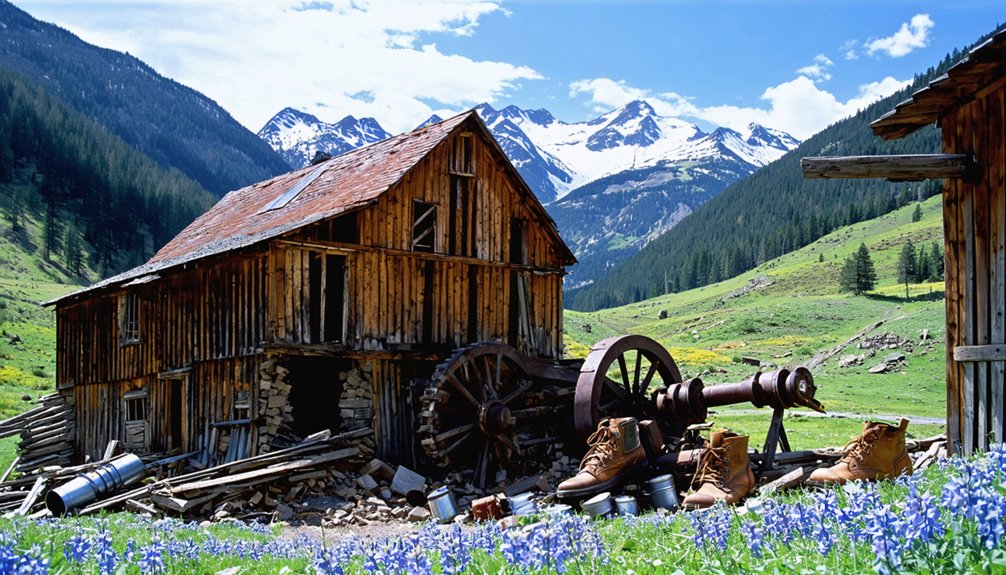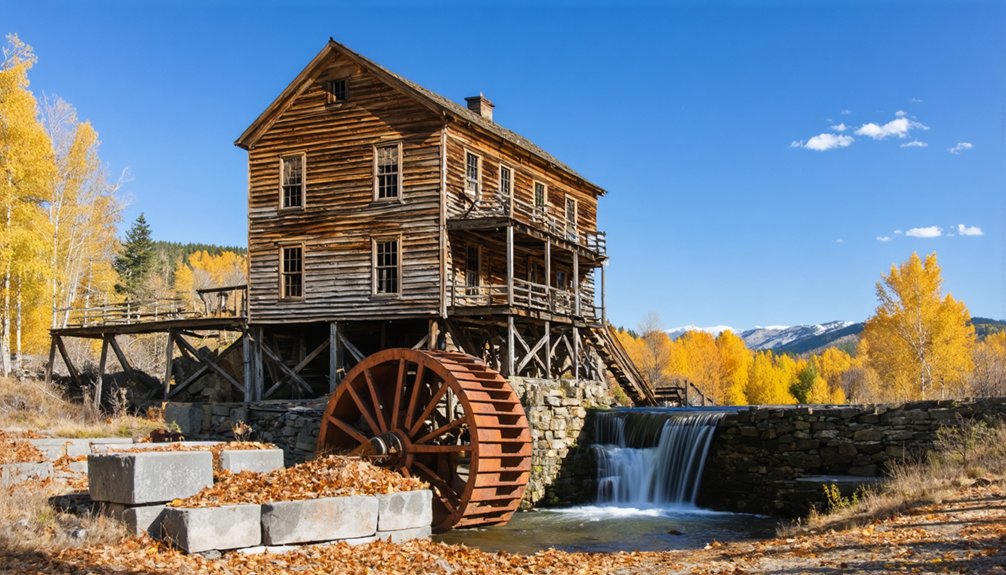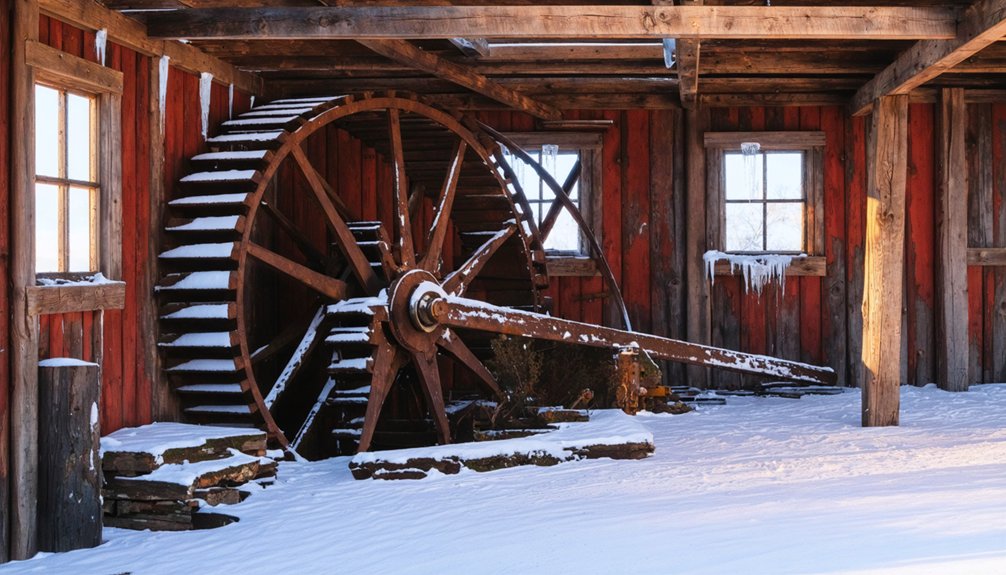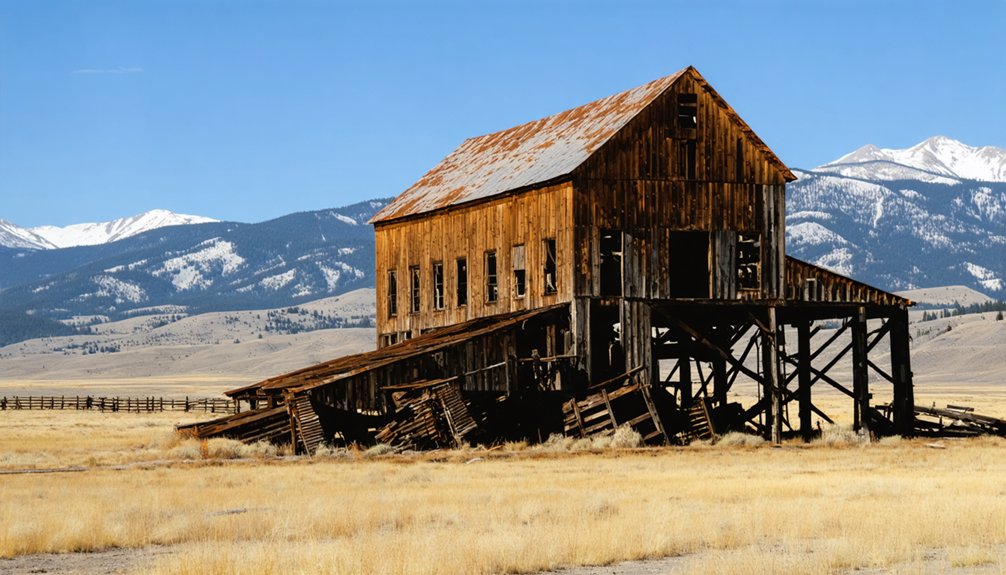You’ll discover Rankins Mill nestled six miles past Iron Springs in Adams County, Idaho at 6,200 feet elevation. This remote mining site began operating by 1902, with over 30 claims staked for gold and copper deposits. While production remained modest at .25 to .50 ounces of gold per ton, the site’s remnants include stamp mills, ore carts, and miners’ cabins. The ghost town‘s rugged trails and scenic Seven Devils peaks hold countless stories of Idaho’s ambitious mining era.
Key Takeaways
- Rankins Mill is an abandoned mining site located six miles past Iron Springs in Adams County, Idaho, at 6,200 feet elevation.
- The site operated from 1902 with 33 mining claims, producing modest gold yields of .25 to .50 ounces per ton.
- Remnants include stamp mills, flotation equipment, ore carts, and deteriorating miner cabins near Black Lake.
- Access requires 2WD vehicles to Iron Springs followed by hiking on rugged trails, with best visiting conditions in summer.
- The ghost town showcases mining technology evolution and reveals the boom-and-bust nature of Idaho’s early mining ventures.
The Journey to Rankins Mill
While Rankins Mill lies approximately six miles past Iron Springs in Adams County, Idaho, you’ll need to plan your journey carefully through this mountainous terrain. You can drive a 2WD vehicle to Iron Springs, but from there you’ll have to hike the remaining distance on rugged trails that once served 19th-century miners. At an elevation similar to Silver City’s 6,200 feet, the air is thin and requires proper acclimatization.
The journey’s difficulties include steep mountain ridges, variable weather conditions, and limited water sources. You’ll pass through dense forests and open ridges, following the same paths that early prospectors used while seeking mineral-rich deposits. Similar to the miners of Bonanza’s gold discovery in 1877, these paths led to significant mineral finds.
Along the way, you’ll encounter scenic views of the Seven Devils peaks and catch glimpses of mining history through abandoned ore carts, tunnel entrances, and mill foundations. Watch for landmarks like White Monument and Horseshoe stream to guide your trek.
Mining History and Operations
You’ll find evidence of early mining ventures at Rankins Mill through the custom mill that operated on West Fork Rapid River by 1902, processing both placer and lode claims.
Similar to Pearl District mines which yielded .25 to .50 ounces of gold per ton, Rankins Mill operated with modest production levels during its peak years.
The site’s mining infrastructure expanded to include over 30 documented claims, though production remained limited compared to other Idaho mining districts.
While eastern investors tried to boost operations during the mid-20th century, the mill’s equipment remnants now stand as silent witnesses to the boom-and-bust cycle that characterized many of Idaho’s mining ventures.
Like many mining operations in the region, Rankins Mill faced similar challenges to those that emerged during the miners’ uprisings of the 1890s over labor conditions.
Early Mining Attempts
During the late 19th century, gold and copper deposits in the Seven Devils area sparked significant prospecting activity around Rankins Mill.
You’ll find that early prospecting challenges included the area’s remote location and difficult transportation access, which hampered development despite initial investor interest from the East.
Around 33 placer and lode mining claims were staked in the vicinity, showing promise for mineral extraction.
Eastern investors funded exploratory work at Iron Springs and Rankins Mill, but you won’t find records of any major ore strikes during these early attempts.
Like many mining operations in the region, the site contained deposits of galena and sphalerite but never achieved large-scale production.
While the region’s mining prospects tied into broader Idaho booms, the site’s isolation proved a persistent obstacle.
The region had experienced violent mining strikes previously, similar to the incidents in the Coeur d’Alene district.
Both placer mining of alluvial deposits and lode mining of hard rock veins were attempted, but operations remained relatively small-scale.
Mill Equipment Remnants
The remnants of mill equipment at Rankins Mill tell a complex story of technological evolution in Idaho’s mining history.
You’ll find foundations and ruins that once supported both stamp mills and flotation equipment, marking the shift from early 1900s crushing methods to more advanced processing techniques.
As you explore the site, you’ll discover fragments of crushing equipment, ore bins, and tailings piles near Black Lake.
These remnants showcase the operational challenges miners faced while processing complex sulfide ores.
The surviving infrastructure includes power equipment foundations and evidence of electrical upgrades that improved ore concentration efficiency.
You can still trace the old road grades and hauling paths that connected the mines to the mills, offering a glimpse into the logistical network that kept these operations running.
Similar to the extensive records of the Day Mines Group, this site provides valuable insights into northern Idaho’s rich mining heritage.
Limited Mineral Production
Despite initial investor optimism, mining operations at Rankins Mill yielded only modest returns after its establishment in 1902. The site’s mineral scarcity and economic limitations led to intermittent production, with ore grades averaging only 0.5 ounces of gold per ton. While profitability estimates suggested potential earnings of $150 per ton, the operation never achieved sustained commercial success.
- Eastern investors funded exploratory work, but operations frequently halted due to insolvency.
- Traditional stamp mills and early flotation techniques limited extraction efficiency.
- The region’s mining slump further challenged sustained operations, leading to eventual closure.
The mine’s limited output stood in stark contrast to the thriving operations in the Coeur d’Alene Mining District, which produced billions in silver, zinc, and lead by the early 1900s.
You’ll find that Rankins Mill’s story mirrors many small-scale mining ventures in Idaho’s less productive districts, where dreams of striking it rich often collided with the harsh realities of mineral scarcity and operational challenges.
What Remains Today
At Rankins Mill today, you’ll find deteriorating foundations of the original buildings and several miners’ cabins scattered across the site.
Similar to Bayhorse’s stone ruins, visitors can explore the weathered remnants that offer a glimpse into Idaho’s mining heritage.
The remnants of the old mill structure still stand as a symbol to the site’s industrial past, though they’re gradually succumbing to the elements.
You can spot abandoned ore carts and visible tunnel entrances that mark the mining operations that once defined this remote Idaho location.
The scenic journey follows along a river and creek bed before reaching this historic mining settlement.
Standing Structures and Ruins
Scattered across the ghost town site of Rankins Mill, several dilapidated structures stand as monuments to its mining heritage.
You’ll find weathered cabins showing extensive deterioration from decades of harsh winters and environmental decay. The mill building remains partially intact, though it’s unsafe to enter, while foundations of other structures outline where the town once thrived.
- Mining remnants include abandoned ore carts and tunnel entrances marking the hub of past operations
- Former miners’ bunkhouses and cabins reveal collapsed walls and missing windows, with wildlife now claiming the interiors
- Natural springs contrast sharply with contaminated areas, where mining effluent has left patches of barren ground
The ruins continue to deteriorate as nature reclaims the site, with minimal preservation efforts to halt their decline.
Mining Equipment and Artifacts
While time has eroded much of Rankins Mill’s mining heritage, you can still find remnants of its industrial past scattered throughout the site.
You’ll discover several hand-dug tunnel entrances, though they’re often obscured by vegetation and partial collapse. Don’t venture inside – these tunnels aren’t maintained or safe to explore.
The most visible artifacts are abandoned ore carts, silent witnesses to the site’s mining techniques.
These basic transport tools, along with the deteriorating mill structure, suggest a modest operation that relied on manual labor rather than advanced machinery.
While specific details about the mill’s equipment remain unknown, the ruins point to on-site ore processing during the late 19th or early 20th century.
The steady equipment deterioration from decades of exposure continues to erase traces of this brief but industrious chapter in Idaho’s mining history.
Life in a Remote Mining Camp

Deep in Idaho’s Seven Devils mining district, life at Rankins Mill revolved around the boom-and-bust cycles common to frontier mining camps. You’d have found yourself living in rudimentary log cabins or tents, braving harsh winters with minimal insulation.
The community dynamics centered on work, with miners forming tight-knit bonds essential for survival in this remote outpost.
Miners relied on each other like family, forging unbreakable bonds as they faced the wilderness together.
- Basic amenities included outhouses, untreated water sources, and shared cooking spaces
- Daily life meant working alongside blacksmiths, carpenters, and teamsters, all dependent on mining success
- Social gatherings happened at simple saloons and general stores, where news and supplies were equally precious
Living conditions were tough, but the promise of striking it rich kept the camp’s transient population moving through, especially when new ore deposits were discovered or market prices shifted.
Seasonal Challenges and Best Times to Visit
Life at Rankins Mill demanded adaptation to Idaho’s challenging mountain seasons. Winters brought extreme cold, with temperatures plunging to 30 degrees below zero, forcing mining operations to halt when dredge ponds froze.
Spring’s snowmelt created treacherous access challenges, turning roads into muddy hazards and causing dangerous creek crossings.
You’ll find summer and fall offer the best visiting conditions. During these seasons, you can navigate the gravel roads with a 2WD vehicle and explore the remaining ruins on foot.
However, seasonal hazards persist year-round in this remote location. Before heading out, always check current weather conditions and road status.
Notable Structures and Artifacts

Today, scattered remnants of Rankins Mill’s mining operations tell the story of its industrial past.
You’ll find multiple tunnel entrances and abandoned ore carts that showcase the early mining techniques used to extract valuable minerals. The site’s mill foundations reveal where workers once processed ore, while deteriorating miner cabins and communal structure remains hint at daily life in this industrial settlement.
- Original mining infrastructure includes tunnel entrances, ore cart remnants, and crumbling mill foundations
- Evidence of past mining techniques can be seen in the leaching pads and processing areas, though environmental impacts are visible in zones of contaminated runoff
- Residential structures, including worker cabins and bunkhouse ruins, offer glimpses of the community’s living conditions
The remaining artifacts paint a picture of a primarily industrial settlement, though many structures have been relocated or lost to time.
The Seven Devils Mining District
Beyond the remains of Rankins Mill lies the broader Seven Devils Mining District, an area that shaped Idaho’s mining legacy since the late 19th century.
The Seven Devils Mining District stands as a testament to Idaho’s pioneering spirit, marking generations of mineral extraction since frontier days.
You’ll find historical geology reflected in complex ore deposits where mining techniques evolved from early copper extraction to significant cobalt production in the 1950s.
The district’s development faced major transportation hurdles, with miners struggling to move ore down steep terrain to the Snake River.
While Kleinschmidt’s road grade and various transport solutions emerged, it wasn’t until 1968 that large ore trucks finally conquered the challenge.
The district’s rich mineral wealth – spanning copper, cobalt, gold, silver, and nickel – peaked during 1949-1959, generating nearly $47.5 million.
Despite periodic shutdowns, the area’s mining claims continue to attract interest, with rehabilitation projects emerging when market conditions improve.
Photography and Exploration Tips

When photographing Rankins Mill‘s weathered structures, you’ll need specialized equipment and techniques to capture the ghost town’s haunting essence.
Pack your wide-angle lens for expansive street scenes and a sturdy tripod for low-light interior shots. You’ll want to shoot in RAW format to maximize your post-processing options, especially for HDR techniques that bring out shadow details inside dim buildings.
- Capture architectural details like ornate door handles, window latticing, and period-specific features unique to Rankins Mill.
- Plan your visit during warm, dry months and bring appropriate off-road vehicles for steep forest roads.
- Document artifacts and machinery while respecting posted restrictions and property boundaries.
Remember to exercise caution around unstable structures and bring essential supplies for remote exploration.
Consider creating both color and black-and-white images to enhance the ghost town’s mysterious atmosphere.
Historical Significance and Legacy
Nestled in Adams County, Idaho, Rankins Mill stands as a monument to the region’s ambitious but ultimately unsuccessful mining ventures. Its historical context reflects a common narrative of western mining towns that attracted eastern investors during America’s mineral rush era.
While copper discoveries in nearby areas generated initial excitement, Rankins Mill’s mining heritage never reached its hoped-for potential.
Despite promising copper finds in the region, Rankins Mill ultimately failed to fulfill its ambitious mining aspirations.
Today, you’ll find only foundations, scattered ore carts, and abandoned tunnel entrances – silent witnesses to dreams that didn’t materialize.
Despite its limited economic success, the site contributes notably to Idaho’s mining history, offering valuable insights into the challenges faced by frontier mining communities.
As nature slowly reclaims the remnants, Rankins Mill continues to serve as an educational resource and a tribute to the pioneering spirit of early Idaho settlers.
Frequently Asked Questions
Are There Any Documented Accidents or Deaths at Rankins Mill?
While you’ll find stories of ghostly encounters and tragic events nearby, there aren’t any specifically documented deaths or accidents at Rankins Mill in available historical records from Idaho’s mining era.
What Types of Minerals Were Primarily Sought at This Location?
You’ll find that gold deposits and silver were the primary targets, with investors backing mineral extraction operations to tap precious metals within the volcanic-rich quartz veins of the region.
Who Was Rankin and Why Was the Mill Named After Them?
You’ll find Rankin’s legacy shrouded in mystery since historical records don’t clearly identify who owned the mill. The name likely came from an early pioneer or entrepreneur during Idaho’s industrial development.
Were Native American Tribes Present in the Area Before Mining?
Yes, Native tribes like the Shoshone and Bannock held cultural significance in the area, using these lands for seasonal hunting, gathering, and migration routes long before mining operations began.
Has Any Gold or Silver Been Found Here in Modern Times?
You’ll find scattered gold discoveries nearby but no major strikes at this location in modern times. While regional silver mining continues elsewhere, there’s limited evidence of significant modern mining specifically here.
References
- https://www.historicsilvercityidaho.com
- https://www.thegoldminehotel.com/ghost-towns-and-haunted-places-in-idaho
- https://history.idaho.gov/wp-content/uploads/2018/12/0116.pdf
- https://www.ghosttowns.com/states/id/rankinsmill.html
- http://freepages.rootsweb.com/~gtusa/history/usa/id.htm
- https://wheninyourstate.com/idaho/this-peaceful-idaho-ghost-town-was-once-americas-most-dangerous-mining-camp/
- https://idaho.for91days.com/the-ghost-town-of-bayhorse/
- https://www.youtube.com/watch?v=P2JgcghKPKQ
- https://yellowpinetimes.wordpress.com/2019/08/25/idaho-history-aug-25-2019/
- https://en.wikipedia.org/wiki/Silver_Valley_(Idaho)



